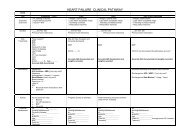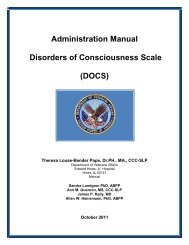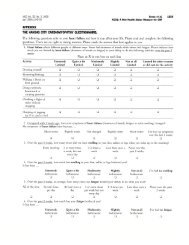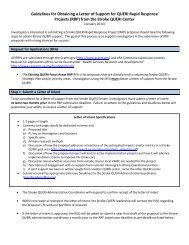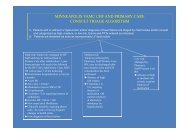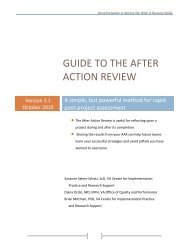The Veteran Supported Education Service Treatment Manual: VetSEd
The Veteran Supported Education Service Treatment Manual: VetSEd
The Veteran Supported Education Service Treatment Manual: VetSEd
Create successful ePaper yourself
Turn your PDF publications into a flip-book with our unique Google optimized e-Paper software.
Summarizing<br />
<strong>The</strong> purpose of a summary is for you to reflect your understanding of a general topic of<br />
discussion. Essentially, this is reflecting on a larger scale. For example, after 10 minutes<br />
of discussion about a variety of interconnected topics (e.g., struggling in school, heavy<br />
alcohol use, PTSD symptoms), you may want to consider summarizing the discussion in<br />
order to help the <strong>Veteran</strong> make connections between them. Thus, you might say, “We’ve<br />
talked about a few things in the past 10 minutes or so and what I’m hearing is that you<br />
have concerns about your relationships with some people at school and also with your<br />
professor. And that makes sense to me. <strong>The</strong>se are important people in your life even if<br />
you might wish they weren’t at this point. You also told me about your flashbacks in the<br />
past week and how upset they’ve been making you. I also know from what you just told<br />
me that you’re feeling more like starting to drink again. If you did go back to drinking,<br />
how do you think it would affect these other problems?”<br />
Connecting <strong>Veteran</strong>s to Mental Health Providers<br />
<strong>VetSEd</strong> services are best provided in the context of wraparound case management<br />
supports. Wraparound case management provides <strong>VetSEd</strong> providers and the <strong>Veteran</strong>s<br />
with whom they work ready access to multidisciplinary providers who can render<br />
evidenced-based treatments for COD. <strong>VetSEd</strong> providers are encouraged to talk with the<br />
multidisciplinary providers with whom they work to determine what evidenced-based<br />
treatments are available at their site. In addition, <strong>VetSEd</strong> providers are encouraged to<br />
reflect on what treatment approaches they have utilized in their own recovery journey, as<br />
sharing small snippets of one‘s recovery story as related to treatment experiences can<br />
build <strong>Veteran</strong> motivation to access clinical services.<br />
Relapse Prevention<br />
<strong>The</strong> ultimate goal of Relapse Prevention (RP) is to teach the <strong>Veteran</strong> how to anticipate<br />
and cope with ―triggers‖ (i.e., moods, thoughts or situations that increase the risk of<br />
using) (Marlatt & Donovan, 2005). RP combines behavioral skills training with cognitive<br />
interventions designed to prevent or limit the occurrence of relapse. Additionally,<br />
psychoeducation is an important component of RP, as both the provider and the client<br />
must identify expectations.<br />
Cognitive Behavioral <strong>The</strong>rapy (CBT)<br />
CBT is based on the assumption that negative feelings result from dysfunctional<br />
thoughts, beliefs, and assumptions about the self, the future, and the world. At times,<br />
<strong>Veteran</strong>s you are working with may exhibit such negative feelings in the form of explicit,<br />
verbal self-statements, otherwise known as negative self-talk.<br />
CBT interventions are designed to help <strong>Veteran</strong>s identify and alter negative self-talk and<br />
related assumptions when they arise, as well as guide an examination of underlying<br />
―cognitive schemas‖.<br />
107 | P a g e



